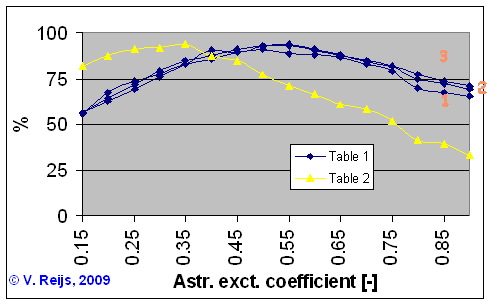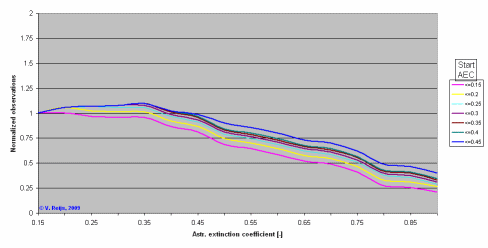Comparing actual and pre/postdicted Babylonian dates of the
Moon's first visibility
The principles behind the comparison:
- The date of the first visibility of the Moon is depending on
several parameters (like astronomy, observation location,
photometric and meteorological parameters). The calculations are
based on Schaefer's criterion.
- Tables with 333 actual Babylonian observations dates (Table 1,
which includes most of Fatoohi's observations [1999])
and
110
Babylonian pre/postdicted observations dates (Table 2) are taken
from S. Stern [2008]. The
dates of Table 2 have thus not actually been observed (due to
the meteorological circumstances on that date [mist, clouds,
rain, etc.]).
- Three observations (-206/1/13, -194/6/6 and -145/2/8) in Table
1 have been changed. The first one is a typo (-206/1/23). For
the remaining two cases I choice to use the observation dates of
Fatoohi [1999]
(-194/6/7 and -145/2/7), as these map better the Babylonian
observation descriptions (pers. comm.: S. Stern [2008], H.
Hunger [2008]).
- The Astronomical Extinction Coefficient (AEC: ktot)
is used to determine the meteorological sensitivity of each of
the tabled Babylonian observations.
- The AEC is varied within realistic boundaries: the minimum AEC
evaluated is 0.15 [-] (best of excellent visibility) and the
maximum AEC evaluated is 0.9 [-] (average of good visibility),
in bins of 0.05 [-]
- Each observation has been attached with a Range of AEC (RAEC),
which predicts the particular tabled Babylonian observation
date: the actual (Table 1) or the pre/postdicted (Table 2) date.
- All observations where the RAEC starts with the same AEC
(Start AEC: SAEC) are grouped
- Starting with the group with the lowest SAEC; the observations
are counted in an accumulated way for all AEC bins.
- Each colored line represents the accumulated count of
observations up to a certain SAEC (see legend in the graph)
- The number of observations is normalized to the number of
observations that have been seen with a SAEC = 0.15 [-].
- Although meteorological and photometric (acuity, age and
luminance of objects) parameters can have a relatively large
influence (1 or in rare case 2 days difference on first
visibility of the Moon: 1-2 IFA [Ideal First Appearance]); it is
relatively small compared to the impact these have when looking
at planets (where it can have 5-6 days IFA). So the Moon's first
visibility is relatively insensitive
to
meteorological and photometric parameters. A comparable
evaluation has been done for Mercury.
Determining the RAEC and SAEC distribution for each table
The following things can be gotten when evaluating the two tables
with the above mentioned method.
- Table 1 graph (positive observations with
actual observation dates):

- All observations can be explained by realistic RAEC.
- A large RAEC is present even for observations that have a
high SAEC
- At the peak of accumulated observations the SAEC is ~0.55
[-]
- As a test the date ordered observations have been split in
three time periods, in all three cases (1 [-567 to -207], 2
[-233 to -161] and 3 [-176 to -73]) the distribution of the
SAEC/RAEC stayed comparable.

- A large range of weather conditions is responsible for this
spread of the observations.And the results of the observation
method(s) seemed to have stayed consistent over the whole
time.
This is what one would expect when doing actual positive
observations.
- Table 2 graph (negative Babylonian observations with
Babylonian pre/postdicted observation dates):

- All observations can be explained by realistic RAEC.
- For the pre/postdicted (negative) observation, it looks the
pre/postdicted date have a small SAEC and a small RAEC.
- The RAECs/SAECs are small compared to RAECs/SAECs seen for
positive observations (Table 1)
- At the peak of accumulated observations the SAEC is ~0.35
[-].
- As a test the date ordered observations have been split in
three time periods (labelled below as 1 [-465 to -245], 2
[-241 to -161] and 3 [-161 to -72]), and the further away the
time period is the more compact the distribution of the
SAEC/RAEC is.

- The above could be due to the pre/postdiction criterion the
Babylonians used; in the earlier periods this criterion looks
to be biased towards good weather situations and might have
changed over time.
- The chances near low AECs are quite high (between 75%-90%),
so the chance of a real first crescent a day earlier than the
pre/postdicted day is smaller than in the observed crescent
Table 1. This could mean that the Babylonian pre/postdicted
criterion was quite accurate.
Conclusions
The use of Schaefer's criterion
For this comparison a 100% proof benchmarking of Schaefer's
criterion is less important, as we do:
- a comparison between two Tables that are handled in the same
way and furthermore
- a kind of averaging is done by looking at the RAEC
distribution.
These two aspects will iron out small
(not big!) deviations in the criterion from the actual behavior.
Schaefer's criterion though adds an essential part to this
evaluation (compared to other criterion): the meteorological
parameters. These meteorological parameters are the most important
for understanding first/last visibility while these parameters are
omitted from all other criterions! So Schaefer's criterion hopefully
will be seen as indeed being able to predict reality better.
No obvious false
observations when using Schaefer's criterion
The early and late accuracy designations by
Stern [2008], come
out in this evaluation as observations under excellent and fairly
good meteorological conditions. So they are in this evaluation not
seen as false.
The validity of Schaefer's criterion needs testing not only in
Babylonian times, but also in recent times; as done in this bench marking process.
Evolution of observations and
pre/postdictions
Looking at the comparable distribution of the RAEC/SAEC for the
split time periods in Table 1; one deducts that no obvious
differences in date determination has happened when actual
observations were done. So it
looks that the results of the observation method(s) were consistent
over time.
When doing a comparable evaluation with Table 2, there is a larger
dependency per time period: the later the dates are the smaller the
SEAC and REAC are.
It looks the pre/postdiction evolves closer to the distribution of
the actual observations. So
did the Babylonian criterion became over time more realistic and
depending on e.g. meteorological parameters?
Comparing the tables
Looking at the behavior of the AEC for each Table/graphs, one can
deduct that the dates in each Table are related to a different
meteorological distribution. So comparing the tables will need to be
done with care due to these statistical/distribution differences.
General
In general, the statement of Stern ([1999], page ) is indeed mapping
the above evaluation; although the
above evaluation is more directly coupled to the meteorological
dependency.
It
seems reasonable that sightings should sometimes be late (for
instance, because of bad weather or atmospheric conditions), and
rarely early (since early sightings are purely erroneous). But
there is no particular reason why non-sightings, which are
effectively pre/postdictions, should sometimes be early never
late. This suggest only that the Babylonian astronomers' new
moon visibility criteria - which we do not clearly know - were
conductive to early pre/postdictions.
Warning about pre/postdictions
Don't forget to check the
general conclusions.
Acknowledgements
I would like to thank the following people for their help and
constructive feedback: Hermann Hunger, Sacha Stern and all other
unmentioned people. Any remaining errors in methodology or results
are my responsibility of course!!! If you want to provide
constructive feedback, let me know.
Major content related
changes: Jan. 29, 2009



